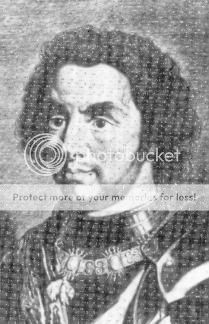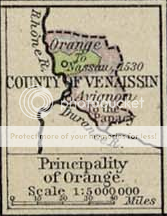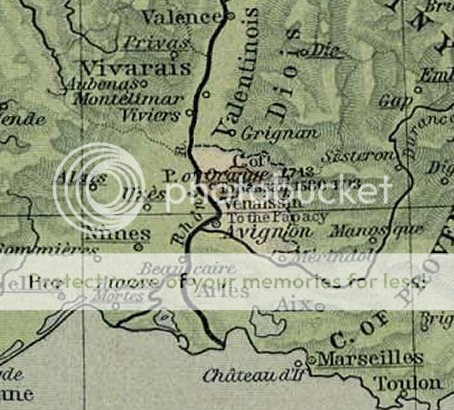- Joined
- Aug 13, 2004
- Messages
- 27,095
- City
- São Paulo
- Country
- Brazil
According to the legens the first Count of Orange was William (Guillaume´ with the horn, a courtier of Charlemagne, who had conquered the city of Orange on the Saracens in 793. As part of the old Kingdom of Bourgondy the county belonged to the Holy Roman Empire since 1032. The countly house splt in two lines in 1150. One of those was elevated in the Empires Pirncedoms by Emperor Frederick Barbarossa. The territory of the second line was inherited after the death of Raimbaud III, through his sister Tiburge III to her husband Bertrand I of Baux. The territory of the countly line first was donated to the order of St. John but Bertrand III reunited Orange in 1308.
After the death of Raimond V of Baux his daughter Maria ingherited the Principality. Through her husband, John III of Chalon it went to the House of Chalon. When the last male memeber of this family, Phillibert of Chalon died, the Principality was inherited by his nephew Count Rene of Nassau, son of Philliberts sister Claudia of Chalon and Henri of Nassau-Breda. Under Rene the territory of Orange became a source of disagreement between Emperor Charles V and the French King Francois I and it was occupied by France several times. Because Rene was without children he named his nephew Willem of Nassau as his heir.
This Willem ´The Taciturn´
, later Stadholder of various Dutch provinces, became Prince of Orange in 1544 and started the dynasty of Orange-Nassau. But in reality he had to wait untill 1559 untill he could actually rule the principality. Under his rule Orange became occupied several times too. After his death Orange was inherited by his sons Philips-Willem, Maurits and Frederik-Hendrik. The heir of the latter was his son Willem II, who was in his turn succeeded by his own son Willem III in 1650. After the Dutch war started in 1673 King Louis XIV of France occupied the territory. Willem III got it back at the peace of Nijmegen in 1678 but in 1685, when 3645se re-ea3ed the edict 6f Nantes the territory was occupied once again. The piece of Rijswijk in 1697 saw another change, the territory was handed over to Willem III again.
After Willem III´s death in 1702 a succession conflict started between Stadholder Johan-Willem-Friso and King Friedrich I of Prussia. The first was, as grandson of Frederik-Hendriks daughter Albertina-Agnes appointed as heir in Willem´s will. But Friedrich, as grandson of Frederik-Hendriks eldest daughter Louise-Henriette also had a claim on the territory according to the will of Frederik-Hendrik. In the mean time Louis XIV declared Orange was part of the French crown. The parlament in Paris gave the principality to Louis pretender, Francois-Louis de Conti, who acknowledged French soubvereinity over Orange. The treaty of Utrecht underlined this decission and gave the Prussians the right to use the weapon and title of Prince of Orange.
Johan-Willem-Friso also hold on to his title Prince of Orange. His son was entitled to this in reality due to a treaty with Prussia in 1732. Since his grandson Willem VI became King WIllem I of The Netherlands the title is bestowed on the eldest son of the King. Today that is the Crownprince Willem-Alexander and the head of the Prussian RF, Prince Georg-Friedrich.

After the death of Raimond V of Baux his daughter Maria ingherited the Principality. Through her husband, John III of Chalon it went to the House of Chalon. When the last male memeber of this family, Phillibert of Chalon died, the Principality was inherited by his nephew Count Rene of Nassau, son of Philliberts sister Claudia of Chalon and Henri of Nassau-Breda. Under Rene the territory of Orange became a source of disagreement between Emperor Charles V and the French King Francois I and it was occupied by France several times. Because Rene was without children he named his nephew Willem of Nassau as his heir.
This Willem ´The Taciturn´
, later Stadholder of various Dutch provinces, became Prince of Orange in 1544 and started the dynasty of Orange-Nassau. But in reality he had to wait untill 1559 untill he could actually rule the principality. Under his rule Orange became occupied several times too. After his death Orange was inherited by his sons Philips-Willem, Maurits and Frederik-Hendrik. The heir of the latter was his son Willem II, who was in his turn succeeded by his own son Willem III in 1650. After the Dutch war started in 1673 King Louis XIV of France occupied the territory. Willem III got it back at the peace of Nijmegen in 1678 but in 1685, when 3645se re-ea3ed the edict 6f Nantes the territory was occupied once again. The piece of Rijswijk in 1697 saw another change, the territory was handed over to Willem III again.
After Willem III´s death in 1702 a succession conflict started between Stadholder Johan-Willem-Friso and King Friedrich I of Prussia. The first was, as grandson of Frederik-Hendriks daughter Albertina-Agnes appointed as heir in Willem´s will. But Friedrich, as grandson of Frederik-Hendriks eldest daughter Louise-Henriette also had a claim on the territory according to the will of Frederik-Hendrik. In the mean time Louis XIV declared Orange was part of the French crown. The parlament in Paris gave the principality to Louis pretender, Francois-Louis de Conti, who acknowledged French soubvereinity over Orange. The treaty of Utrecht underlined this decission and gave the Prussians the right to use the weapon and title of Prince of Orange.
Johan-Willem-Friso also hold on to his title Prince of Orange. His son was entitled to this in reality due to a treaty with Prussia in 1732. Since his grandson Willem VI became King WIllem I of The Netherlands the title is bestowed on the eldest son of the King. Today that is the Crownprince Willem-Alexander and the head of the Prussian RF, Prince Georg-Friedrich.










